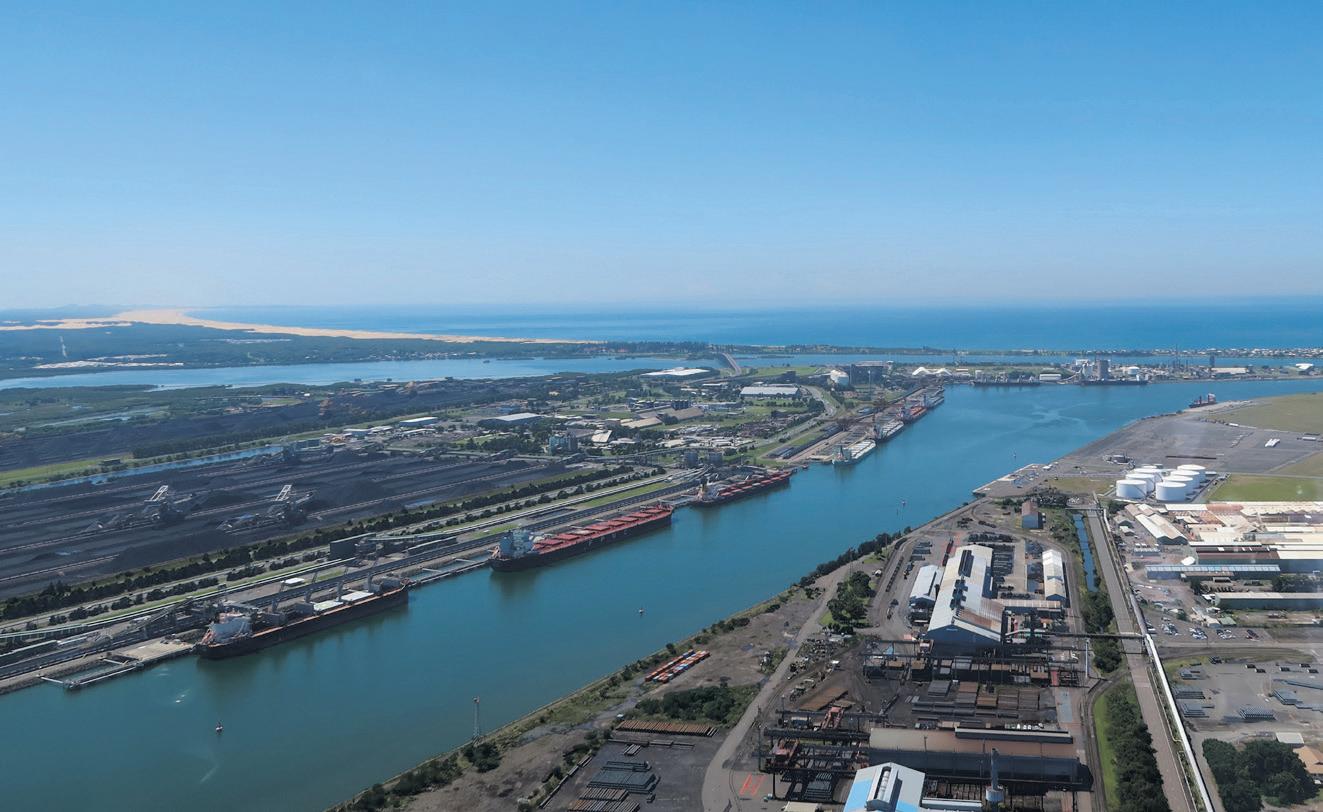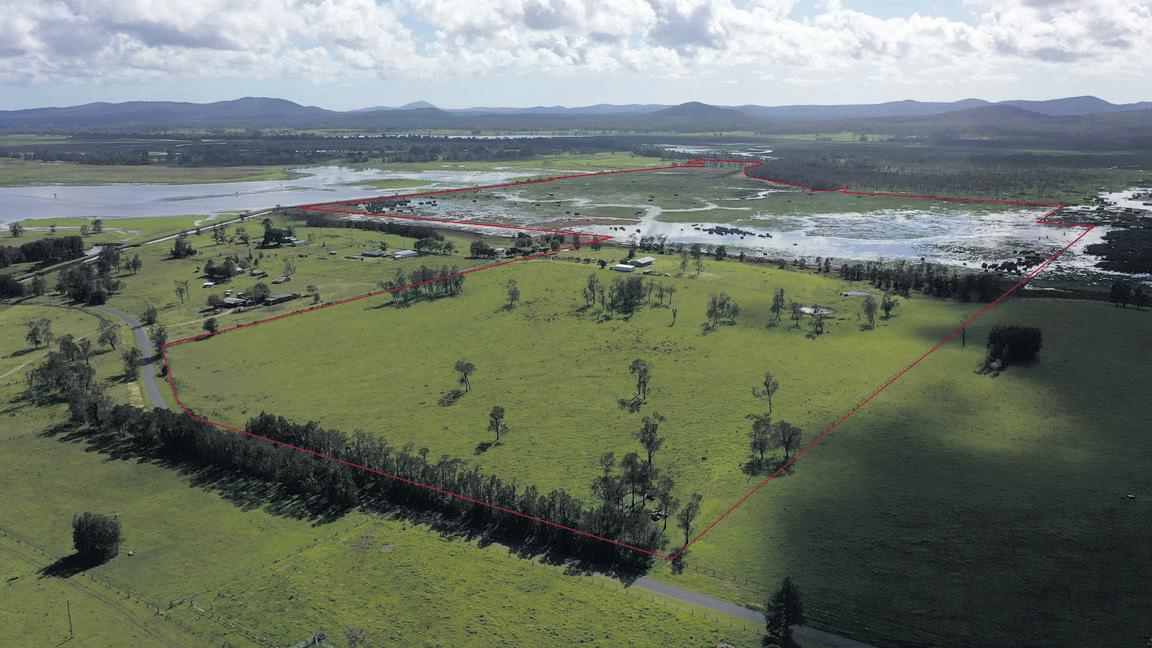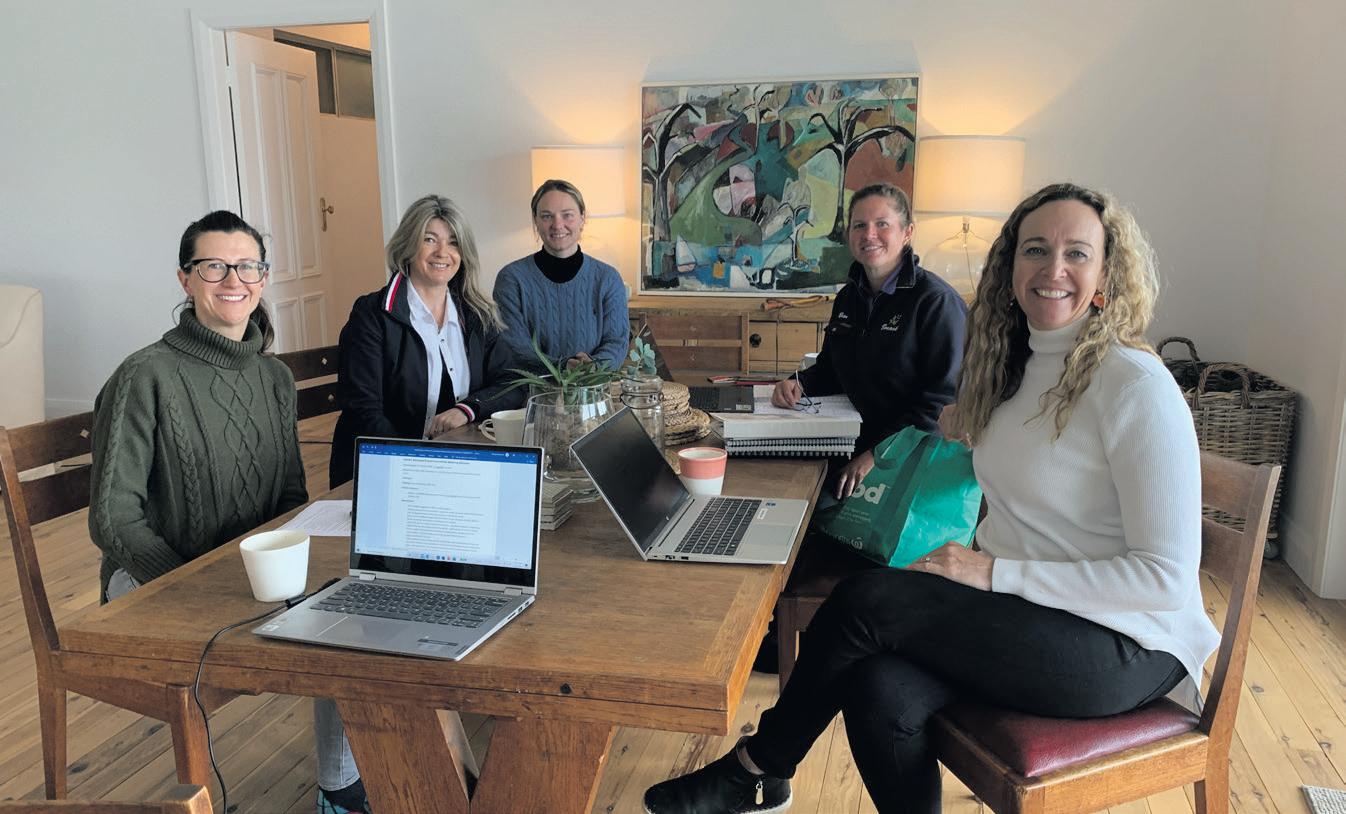
18 minute read
Rural
RECENT CATTLE MARKET REPORTS
CASINO
NRLX MARKET REPORT WEEK ENDING FRIDAY 25 NOVEMBER
Agents yarded a total of 1,079 head at the Northern Rivers Livestock Exchange regular prime sale on Wednesday 23 November. Young cattle made up the majority with less export types available. Light weaners dominated the offering particularly through the steer section. The best of the heifers sold well but plainer quality through the secondary drafts of both categories resulted in a softer market. All the regular buyers attended. Cow prices saw a drop this week averaging 287c/kg and reaching a top price of 434c/kg. Lighter heifer prices were softer with those up to 250kg averaging 551c/kg and topping their category at 778c/kg. Heavier heifers were dearer with those up to 250kg averaged 436c/kg and reaching a top of 550c/kg.
Bull prices were easier this week with 20 head sold averaging 277c/kg and 632kg. Steer prices held frm to slightly cheaper with those up to 250kg averaging 615c/kg and reaching a top of 772c/kg. Heavier steers over 250kg averaged 505c/kg and topped their market at 646c/kg. A good number of bullocks sold on the day averaged 331c/kg and reached a top of 340c/kg. Vealer prices held frm this week averaging 561c/kg and 208kg and reaching a top of 770c/kg.
Ian Weir & Son held a store sale at the NRLX on Friday 25 November with 1,227 head going under the hammer. Steers topped their category at 698c/ kg and averaged 537c/kg and 223kg whilst heifers reached a top of 670c/kg and averaged 508c/kg and 209kg. Cows reached a top price of $2,050 whilst Cows & Calves topped their market at $3,600.
T&W McCormack and Ramsey & Bulmer will hold a store sale this Friday 2 December with 1200 head booked. Further bookings are welcome.
WARWICK
LIVESTOCK MARKETS WARWICK W/E 25/11/202
Larger numbers were presented for the weekly Cattle and Sheep and Lamb sales this week. Vendors took the opportunity to sell stock as the paddocks and roads allowed more movement of stock. The prices were frm for most categories with the heavir export tpyes slowing down. The selling season has 3 more sales for the cattle and sheep with the selling fnishing on the 14th December for 2022 and re-commencing on the 10th of January 2023.
Vealer steers averaged 550.7c/kg topping at 696.2c/kg or $1287.85 to $1945.48 Vealer heifers averaged 525c/kg topping at 648.2c/kg or $1304.28 to $1593.15 Feeder steers averaged 492.3c/kg topping at 586.2c/kg or $1857.36 to $2484.92 Feeder heifers averaged 417.5c/kg topping at 499.2c/kg or $1597.46 to $1946.88 Yearling steers averaged 531.5c/kg topping at 630c/kg or $1540.41 to $1998.48 Yearling heifers averaged 442.8c/kg topping at 602.2c/kg or $1426.45 to $1861.29 Steers averaged 399.1c/kg topping at 540c/kg or $2142.77 to $2869.74 Heifers averaged 367.5c/kg topping at 499.2c/kg or $1784.36 to $2640.45 Cows averaged 301.1c/kg topping at 350.2c/kg or $1633.52 to $2459.20 Bulls averaged 373.9c/kg topping at 620c/kg or $1697.61 to $4072.32 Lambs topped at $232 to average $145.29 a drop of $9/ head Hoggets topped at $161 to average $110.53 a jump of $9/ head Ewes topped at $148 to average $73.47 a jump of $17/head Wethers topped at $161 to average $99.58 a drop of 21/ head Rams topped at $128 to average $92.24 a drop of $19/head Lamb rams topped at $165 to average $139.62 a jump of $26/head Ewe lambs topped at $165 to average $127.48 a drop of $29/head The total of 2473 head averaged $120.82/head a drop of $15/head on last sale. Sows sold from $88 to $365, Boars to $42, Baconers from $200 to $280, Pork from $150 to $200, Stores from $70 to $170 Ducks sold to $7.50, Ducklings sold to $22.50, Roosters sold to $20, Hens sold to $25, Turkeys sold to $37.50
WARWICK
MC DOUGALL & SONS SHEEP & LAMB REPORT
Numbers were up today as Agents and vendors combined to yard 2473 head for the weekly sale. The buying panel was enthused and saw good competition between the export buyers. The light and feed on types were price sensitive to the weight and type for the background buyers or back to the paddock buyers. The stock today was drawn from the Maranoa, Western and Southern Downs as well as local vendors. Lambs topped at $232 to average $145.29($9down0, hoggets topped at $161 to average $110.53($9up), ewes topped at $148 to average $73.47($17up), wethers topped at $161 to average $99.58($21down), rams topped at $128 to average $92.24($19down), lamb rams topped at $165 to average $139.62($26up), ewe lambs topped at $165 to average $127.48($29down). The total yarding averaged $120.82 a drop of $16/head on last week’s sale. Warren & Tracy Ohl sold Dorper lambs 48.8kg to GR Prime for $171, 53.5kg hoggets to Eversons for $119 Pikedale Past Co sold Dorper x sucker lambs 41.5kg to restockers for $121, 36kg to restockers for $89, 33kg to restockers for $91 Rory & Kathy Frost sold 42kg Dorper lambs to Highchester Meats for $180 Palmer Steel Trading P/L sold Dorper lambs 61.56kg to Thomas Foods for $216, 54.2kg to Eversons for $200, 50kg to Eversons for $186, 67.5kg hoggets to Eversons for $145 Cooinda P/S sold Xbred lambs off grain 48.07 to Uniplaza Meats for $160, hoggets 50kg to Uniplaza for $130 Sharpe Past Co sold Dorper x lambs 76.5kg to Thomas Foods for $215, 68.15kg Xbred lambs to Thomas Foods for $215, 57.7kg Xbed lambs to Eversons for $196, 80kg hoggets to Eversons for $140, Xbred ewes to Thomas Foods for $100 and $92 Jack & Sally Sloss sold Merino ewes cfa to Thomas Foods for $80, rams to Eversons for $50 Kylee Simpson sold Dorper x lambs 42kg to Eversons for $140, 34kg to restockers for $110, 53kg hoggets to restockers , 4th ewes to restockers for $148, ewe & lamb units to restockers for $135 Les Holten sold Dorper ewe & lamb units to Highchester for $210, 36kg lambs to restockers for $102 Geoff & Rosemary Gibson sold Xbred lambs 60kg to Thomas Foods for $195, 60kg hoggets to Eversons for 130, 4th wethers to restockers for $100 Shelley F/T sold 61.5kg lambs to Thomas Foods for $204, 80kg to Eversons for $232
TENTERFIELD
BROUGHT TO YOU BY HAROLD CURRY PH: 02 6736 1344 Heifers sell to $2,408.45 Sale Date: 21.11.2022 Number Yarded: 341
Numbers increased this sale with a total yarding of 341 head. A mixed quality yarding saw prices cheaper across all sections in line with other selling centres. A small but quality yarding of steers sold to 482.2 cents, no bullocks were yarded. In the Cow section, heavy weight cows sold to 328.2 cents, medium weights reached 315.2 cents with heifers selling to 350.2 cents. In the trade section weaner steers topped at 604.2 cents, while the heifer portion reached 505 cents, both returning to the paddock. A mixed yarding of Bulls sold to 300 cents.
TOP PRICES
BULLOCKS: No Quote $ 0; STEERS: Kelvingrove Pty Ltd $ 2499.00; COWS: GO Robertson $ 2242.63; HEIFERS: A & N Saccon $ 2408.45; YEARLINGS: Kelvingrove Pty Ltd $ 2000.04; VEALERS: PW & CM Potter $ 1874.02; BULLS: PL Carpenter $ 2759.97;
VEALERS
Light Strs. 570.0 av. 443.7 Hfrs. 500.0 av. 430.0 Heavy Strs. 604.2 av. 500.8 580.0 av. 551.6 Hfrs. 505.0 av. 475.9 430.2 av. 430.2
YEARLINGS
Steers 610.2 av. 506.5 Heifers 478.2 av. 463.5
HEIFERS
350.2 av. 342.2
Steers up to 400kg 482.2 av. 482.2 Steers 400-500kg 440.0 av. 425.9 Steers 500kg plus 421.2 av. 420.4
COWS
Light No Quote; Medium 315.2 av. 309.3; Heavy 328.2 av. 321.5; Bulls 600kg+ 300.0 av. 255.2
NEXT SALE: 5th December 2022, 9:00am Start
CONTACT US - The Northern Rivers Times Rural Edition ✆ 1300 679 787
SALES 02 6662 6222 sales@nrtimes.com.au ✆ Albury - 02 6080 9520, Casino - 02 6662 6222, Dubbo - 02 5858 4078, Grafton - 02 5632 3041, Moree - 02 6794 3889, Tamworth - 02 5719 1656, Wagga Wagga - 02 5940 8516 Directors, co-owners and co-founders: Jeffrey Gibbs and Sharon Bateman ISSN: 2652-7928 a Heartland Media company ABN: 84 134 238 181 All rights reserved © 2022 Distribution Coffs Harbour north to Southport and west to Tenterfield weekly.
STATE’S CHANCE TO FULFILL CHRISTMAS WISH SUMMARY OF KEY ISSUES
The state government is being asked to give farmers some Christmas cheer by fast-tracking work around the Port of Newcastle.
Earlier this month a bill that would enable the development of a container terminal at the Port of Newcastle passed the NSW Parliament, meaning farmers were closer than ever to substantial savings on freight costs.
NSW Farmers Modernising Rail Taskforce chair Matt Madden said the onus was on the state government to proceed with bureaucratic work to unlock that potential.
“By swiftly proceeding with the work around the Port of Newcastle, the state government could offer a little hope coming into Christmas after a particularly shocking year for farmers and rural communities,” Mr Madden said.
“We’ve seen one of the most expensive crops in history being hit by multiple natural disasters, and everyone could do with a bit of a cheer up.
Mr Madden urged the government to prioritise the Port of Newcastle Bill for assent and to appoint the independent assessor before Christmas to get the process underway. He said it was important to get the ball rolling on developing new container freight capacity sooner than later, to maximise the opportunities for regions recovering for natural disasters.
“Giving growers the opportunity to send more containerised produce through the Port of Newcastle in a more effcient manner would save farmers between $16 and $22 per tonne, or up to $2.8 billion over the next 30 years, allowing them to reinvest in their businesses and drive even more economic activity in the regions,” Mr Madden said.
“This will save farmers money, grow the state economy, reduce strain on our roads, reduce truck emissions, and help the Hunter Valley in its eventual industrial transition away from coal mining.
“After all of these foods and damage this year, and with the Parliament having backed the bill, all that’s required is the will to deliver a fairly simple process that will in turn give farmers a long-awaited Christmas gift.” For the week ending 23 November 2022, cold fronts across southern Australia brought signifcant rainfall and strong winds. Weekly rainfall totals exceeding 50 millimetres were observed across alpine areas of New South Wales and Victoria, northern parts of Western Australia and the Northern Territory, western Tasmania, and parts of northern Queensland and Victoria.
Moderate rainfalls across southern New South Wales and Victorian cropping regions are likely to have prolonged the waterlogging of winter crops and exacerbated fooding of low-lying crops in riverine areas. Another week of dry conditions across most of Queensland and northern New South Wales will have allowed harvesting of winter crops and planting of summer crops to continue. In Western Australia, harvesting activity continued with minimal delay on the expected large winter crop.
La Niña continues in the tropical Pacifc, with atmospheric and oceanic indicators refecting a mature La Niña event. Meanwhile, sea surface temperature anomalies across the northern Indian Ocean have eased signifcantly over recent weeks, refecting the decline in the negative Indian Ocean Dipole (IOD) event. The Southern Annular Mode (SAM) is currently positive and is likely to remain positive into early summer. A MaddenJulian Oscillation (MJO) of moderate strength is active over the western Pacifc Ocean, increasing rainfall over northeastern Australia.
The rainfall outlook for December 2022 to February 2023 suggests there is a greater than 60% chance of exceeding median rainfall across most of Victoria, southern and eastern New South Wales, eastern Queensland, Tasmania, and eastern parts of South Australia. As crops in these regions reach the fnal stages of maturation, a continuation of wet conditions may cause further grain quality downgrades and delay harvesting. Moreover, the wet conditions are likely to continue to interrupt the planting of summer crops.
Over the 8-days to 1 December 2022, low-pressure systems and a broad trough is forecast to bring moderate to heavy rainfall to northern and eastern Queensland, and northern areas of the Northern Territory and Western Australia. Moderate falls forecast across most cropping regions in Queensland and northern New South Wales are likely to bring renewed delays to the harvesting of winter crops and planting of summer crops following two relatively dry weeks. The easing of wet conditions
across food-affected
cropping regions of south-eastern Australia
will likely allow foodwaters to recede
and reduce the risk of
further waterlogging and reductions in yield potential.
Water storage levels in the Murray-Darling Basin (MDB) decreased between 16 November
2022 and 23 November
2022 by 70 gigalitres (GL). Current volume of water held in storage is 23 938 GL which
represents 95 per cent of total capacity. This is 5 percent or 1219 GL more than at the same
time last year.
Allocation prices in the Victorian Murray below the Barmah
Choke increased from $24 per ML on 17 November to $26 per ML on 24 November
2022. Prices are lower
in the Goulburn-Broken
due to the binding of the Goulburn intervalley trade limit.

Sale Dates
Tuesday 29th November - Fat Sale 8am Tuesday 6th December - Fat Sale 8am Thursday 15th December Store Sale 9am - last sale for the year
Clearing Sale

Saturday 7th of January 2023 3089 Big River Way Ulmarra NSW 2462 MORE INFO TO COME
Property of the Week 788 Avenue Road, Lavadia $1,350,000 This 237.8 acre property is situated 20 mins from the Grafton CBD, on the coastal side of town – just 25 mins drive to the beach. The property boasts 45 acres of entirely flood-free land, with neat improvements which make this one the whole package. The three bedroom home is of generous proportions & was constructed in 2010. It is of steel & Colourbond construction and is well insulated. The home enjoys a fabulous aspect & the kitchen and living area flow out to a generous alfresco area. The master bedroom has a brilliant view out to Glenugie Peak, and storage has been well-considered throughout the entire home. It is important to note that Clarence Valley Council has allowances for Dual Occupancy builds, meaning you would be able to construct a second residence on the property (Subject to Council Approval of course). This would be perfect for extended families wanting to live on the same farm, or someone wanting to build their dream home and either convert the current house to a shed, or leave it as a residence and rent it out for additional income. There is an additional 5 bay farm shed plus a set of cattle yards. The property is situated at the headwaters of the Coldstream River, and locals will know this area as “The Forks”. Currently, most of the wetland area has water laying on it, and the birdlife is simply spectacular. During a dry season, the low country becomes abundant with swamp couch – ideal for fattening steers, bullocks or cows. Please phone JoJo 9 Coldstream Street, Ulmarra NSW 2462 - David Farrell 0437 448 455 - Office 6642 5200 Newby on 0417 69 637 to arrange your inspection.
Traceability is key to maintaining freedom from disease, pests
The sheep industry here in Australia enjoys freedom from many of the world’s major diseases, including foot and mouth disease (FMD), sheep pox and scrapie, which can have devastating consequences for longterm sustainability.
But the recent incursions of varroa mite in the honeybee industry and Japanese encephalitis affecting pigs, and the threat posed by FMD being present in Indonesia, show that our island geography and excellent biosecurity standards cannot always prevent pests and diseases.
There is no such thing as zero risk. It’s critical that the sheep industry remains alert and adaptable and avoids complacency, particularly in implementing biosecurity practices and traceability systems that will guard against incursions and minimise their impact.
Everyone has a role to play, from livestock producers to supply chain participants to government and the community in general.
This means ensuring sound biosecurity practices. Control the entry of people, vehicles and animals onto your property; ask for health declarations for all purchased or agisted livestock; make sure that anyone or anything that does enter the property is appropriately treated or disinfected; and inspect and quarantine introduced animals, to ensure that any diseases or parasites are detected before they join the rest of the fock or herd.
Freedom from disease means we need fewer chemical, antimicrobial and other treatments to maintain high levels of health and welfare in our sheep, and it minimises the impact of diseases we already have, such as footrot and lice, as well as noxious weeds.
And it gives our sheep products an international trading advantage – Australia has a high degree of market access and a reputation for products that are clean, green and safe to use. But it’s the growth in global trade and interaction between countries, combined with climate change, that is expanding the reach of exotic diseases across borders.
The Sheep Sustainability Framework (SSF) has four distinct themes: Caring for our Sheep, Enhancing the Environment and Climate, Looking after our People, Customers and Community, and Ensuring a Financially Resilient Industry. These are not ranked in order of importance. They are all interdependent.
The impact of climate change is closely linked with animal health and welfare, biosecurity and market access. As the world’s climate changes, the industry is facing the impact of rainfall variability, temperature fuctuations, and natural disasters. As temperatures increase, changes in rainfall and humidity affect the reproduction and geographic spread of pests and disease vectors such as fies, ticks, and mosquitoes. Biosecurity risks from climate change can seriously impact market access and the fnancial resilience of the sheep industry.
The simple reality is that disease does not respect boundaries. This makes traceability systems like the National Livestock Identifcation System (NLIS) and programs like Livestock Production Assurance (LPA) critical to the prevention, identifcation, control and elimination of a disease outbreak, and shares the responsibility for monitoring across industry, regardless of state and territory boundaries.
Electronically identifed livestock (eID) can be traced with greater effciency and accuracy than visually identifed livestock. The faster that livestock can be traced, the greater the chance of controlling a disease outbreak and minimising its economic and social effects.
An outbreak of an emergency animal disease like FMD in Australia would be devastating. Even if it was quickly contained and eradicated, it would still take around 18 months before we could return to a formal status of freedom without vaccination, and regain the market access we have now.
Effective traceability relies inherently on industry compliance and national consistency.
When systems are fully supported and activated, the benefts of improved traceability to biosecurity and market access will accrue across the entire value chain.
The beef industry is already seeing a spreading of insect pests like ticks and buffalo fies and some internal parasites are becoming either more localised or concentrated, or more widely distributed.
We will need to work smarter and more collaboratively, harnessing technology and data to drive biosecurity innovation.
Biosecurity impacts on the health of the fock, the viability of farmers, the reputation of Australia as a premium trading partner, and the sustainability of the sheep industry, and traceability is a key element to ensure we stay healthy for the long term. To quote Thomas Jefferson, ‘The price of freedom is eternal vigilance.’

Dr Scott Williams, Chair of the Sheep Sustainability Framework’s (SSF) Sustainability Steering Group (SSG).
WOMEN HELPING DRIVE FARMERS SUCCESS
Australia’s largest farm advocacy body is celebrating six years of consecutive membership growth, driven in large part by women taking on leadership roles.
Bucking the downsizing trend among member-driven organisations, NSW Farmers branches are growing and an increasing number of leadership roles are being flled by female farmers.
NSW Farmers Regional Service Manager Catriona McAuliffe said one of her branches – at Harden – was entirely run by women.
“They say if you want something done, get a country woman to do it, and our ladies are certainly getting things done,” Mrs McAuliffe said.
“Women have always played a crucial role in agriculture, handling a lot of business operations while also traditionally raising the family.
NSW Farmers Harden Branch chair Bronwyn Ryan said more people were accepting of women working in agriculture, challenging the stereotype of “the old bloke in a ute”. “My daughters grew up helping out around the farm, and now they’re both really passionate about agriculture and sharing that with the world,” Mrs Ryan said.
“More and more women are getting hands-on in the running of the family farm, and I think it’s a good thing because they’re not afraid to stand up for what they believe in.
Over the past six years the NSW Farmers membership base has grown by almost 10 per cent despite – or perhaps because of – the challenges of drought, bushfres, COVID-19, mouse plagues and fooding. NSW Farmers Vice President Rebecca Reardon said one of the reasons women were increasingly getting involved was the focus not just on specifc commodities, but the broader policy issues around rural communities such as health, education, telecommunications and business.
“Farmers recognise the need for a strong conduit between paddock and policy-making, and our strong presence both in the regions and in front of decision-makers really sets us apart,” Mrs Reardon said.
“We are one of the only organisations of our kind with staff on the ground in the regions, and this has been driven by local grassroots engagement on important issues.












